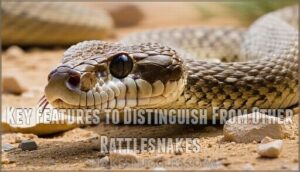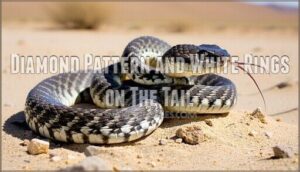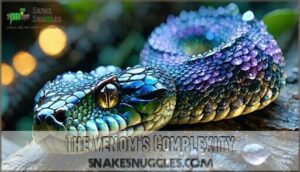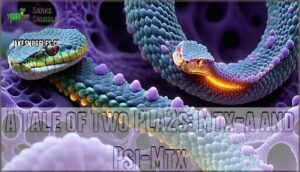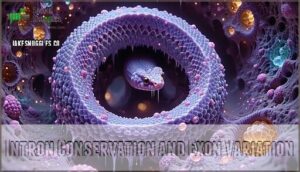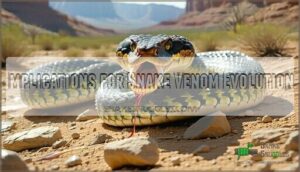This site is supported by our readers. We may earn a commission, at no cost to you, if you purchase through links.
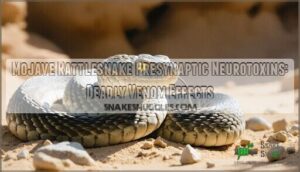
These toxins, especially the Mojave toxin, block acetylcholine release at nerve endings, so muscles can’t contract.
Imagine your body’s electrical system short-circuiting: paralysis, trouble breathing, and sometimes worse.
The venom’s presynaptic β-neurotoxins work fast, making medical care urgent.
Antivenom is your best bet if bitten, but don’t count on luck.
Understanding these neurotoxins isn’t just academic—it’s survival.
Stick around, because the Mojave rattler’s venom has a few more tricks up its scaly sleeve.
Table Of Contents
- Key Takeaways
- Mojave Rattlesnake Bite Risks
- Identifying The Mojave Rattlesnake
- The Venom’s Complexity
- Mojave Toxin and Its Pseudogene
- Implications for Snake Venom Evolution
- Frequently Asked Questions (FAQs)
- Does rattlesnake venom have neurotoxins?
- What is mojave toxin?
- Are rattlesnakes hemo or neurotoxic?
- Which snakes have neurotoxins?
- What should I do if I see a Mojave rattlesnake?
- What are the chances of dying from a Mojave rattlesnake bite?
- What are the symptoms of a Mojave rattlesnake bite?
- How can I tell the difference between a Mojave rattlesnake and a Western Diamondback?
- What should I do if Im bitten by a Mojave rattlesnake?
- How does geographic location affect neurotoxin potency?
- Conclusion
Key Takeaways
- You’re facing one of North America’s most dangerous snake venoms when bitten by a Mojave rattlesnake – its presynaptic neurotoxins block nerve signals and can cause fatal paralysis within hours
- You’ll need immediate medical attention and antivenom treatment if bitten – delayed care allows the toxins to spread through your nervous system, making recovery much harder and potentially causing permanent damage
- You can identify Mojave rattlesnakes by their distinctive diamond back pattern, white-ringed tail bands, and postocular stripe behind the eye – proper identification helps medical teams provide the right antivenom
- You’re dealing with a complex venom system where Type A populations carry deadly Mojave toxin while Type B populations cause more tissue damage – geographic location affects the type of toxicity you’ll face
Mojave Rattlesnake Bite Risks
If you’re bitten by a Mojave rattlesnake, you’re facing one of North America’s most dangerous venomous snakes due to its potent presynaptic neurotoxins.
The Mojave toxin can cause severe neurological symptoms and potentially fatal paralysis, making immediate medical attention critical for survival.
Mojave Toxin’s Lethal Effects
When you’re dealing with a Mojave rattlesnake bite, you’re facing one of nature’s most potent neurotoxic venoms.
You’re staring down a biochemical nightmare designed to shut down your nervous system in minutes.
The mojave toxin acts as a presynaptic toxin that blocks acetylcholine release at nerve terminals, leading to rapid paralysis mechanisms that can prove fatal.
This neurotoxin effects your nervous system through several deadly pathways:
- LD50 Values: Purified mojave toxin shows extreme potency at just 0.056 mg/kg in laboratory tests
- Cellular Damage: The toxin triggers inflammatory responses and oxidative stress in neural tissues
- Paralysis Mechanisms: Respiratory muscles fail as diaphragm nerves stop responding to stimulation
- Neurotoxic Tradeoffs: The mojave rattlesnake evolved this evolutionary advantage, trading tissue destruction for rapid prey immobilization
The neurotoxic venom creates irreversible blockade of muscle contraction, making quick medical intervention absolutely critical. Injection of the toxin can lead to respiratory system failure, causing death in mice.
Delayed Medical Care Consequences
Time matters with Mojave rattlesnake bites. Delaying snakebite treatment allows Paralysis Progression to advance, creating Treatment Complications that reduce Antivenom Efficacy.
Every second counts when mojave venom starts shutting down your nervous system.
Without prompt emergency services, victims face Long-Term Effects including respiratory failure and permanent neurological damage.
Knowing common venomous snake identification can be life-saving.
Recovery Challenges multiply as neurotoxins spread through your system. Don’t wait—seek medical attention immediately for effective snakebite management.
Antivenom’s Crucial Role in Treatment
When medical care gets delayed, you’ll need antivenom to counter the Mojave rattlesnake’s deadly effects.
This specialized treatment becomes your lifeline against mojave toxin’s devastating neurological assault.
Antivenom products are available for mojave antivenom treatment.
Antivenom efficacy depends on several key factors:
- Treatment window: You’ve got the best shot when antivenom’s administered within hours of the snakebite
- Dosage strategies: Doctors calculate precise amounts based on your symptoms and venom toxicity levels
- Allergic reactions: Medical teams monitor you closely since some people develop sensitivity to antivenom proteins
- Rattlesnake venom neutralization: The antivenom specifically targets presynaptic neurotoxins that cause paralysis
- Future research: Scientists continue developing improved formulations for better snakebite treatment outcomes
Getting antivenom fast makes all the difference between recovery and serious complications from rattlesnake venom exposure.
Identifying The Mojave Rattlesnake
You’ll need to recognize this dangerous snake’s distinctive features to avoid a potentially fatal encounter.
The Mojave rattlesnake has a clear diamond pattern down its back and distinctive white rings around its tail that contrast sharply with black bands.
Key Features to Distinguish From Other Rattlesnakes
Spotting a mojave rattlesnake requires sharp eyes and knowledge of key features. These venomous snakes share similarities with other species, making identification tricky but manageable.
Look for these distinctive markers:
- Postocular stripe – extends behind the eye above the mouth corner
- Supraocular scales – separated by fewer than four small scales between them
Scale patterns and geographic location help confirm identification. Western Diamondbacks cause confusion, but mojave rattlesnakes show clearer postocular stripes. You can find snake-related products here. Their venom type contains potent neurotoxins, making proper identification essential for medical treatment.
Diamond Pattern and White Rings on The Tail
You’ll notice the Mojave rattlesnake’s distinctive diamond pattern running down its back, with each diamond outlined in dark borders.
The tail markings are particularly telling—look for alternating black and white rings on the tail, with the white rings being remarkably brighter and more contrasted than other rattlesnake species.
This tail morphology serves a camouflage purpose, helping with predator evasion in desert environments where regional variation in coloration genetics creates these striking patterns, which can be considered a result of regional variation.
Postocular Stripe and Supraocular Scales
When examining a mojave rattlesnake, look for the distinctive postocular stripe that runs diagonally from behind each eye toward the jaw.
This dark marking contrasts sharply against lighter facial scales.
The supraocular scales above each eye appear separated by fewer than four small scales between them.
These identification markers help distinguish mojaves from other rattlesnake species, though hybridization effects and geographic differences can cause stripe variation in scale morphology patterns.
The Venom’s Complexity
You’re about to encounter one of nature’s most sophisticated chemical weapons systems.
The Mojave rattlesnake’s venom contains a deadly cocktail of toxins that work together to shut down your nervous system with frightening efficiency.
Rattlesnake Venom Composition
Rattlesnake venom composition varies dramatically by geographic variation, creating distinct venom phenotypes.
Mojave Toxin dominates Type A populations with deadly LD50 ranges of 0.3-4 mg/kg, while Type B lacks this neurotoxin but contains powerful metalloproteases activity.
This snake venom cocktail targets your nervous system, with presynaptic neurotoxins disrupting acetylcholine release at synapses.
Type A venom exposure can trigger a neurocellular stress response.
Presynaptic Neurotoxins’ Role in Paralysis
Several presynaptic neurotoxins target your nervous system’s communication network, causing devastating effects. Mojave toxin disrupts synaptic transmission by blocking acetylcholine release at nerve terminals.
This rattlesnake neurotoxin triggers membrane disruption and calcium overload, creating a cascade of cellular damage. The presynaptic effects lead to neurotransmitter blockade, preventing normal nerve-muscle communication.
- Acetylcholine impairment stops muscle contraction signals
- Calcium overload destroys cellular function and triggers inflammation
- Neurotoxicity progresses from weakness to complete paralysis
Acidic Subunit’s Function in Neurotoxic Activity
Mojave toxin’s acidic subunit acts as a molecular chaperone, guiding the toxic basic subunit to its target.
Without this acidic subunit function, the PLA2 interaction fails, and neurotoxic activity drops dramatically. Think of it as a delivery service – the acidic subunit role guarantees proper neurotoxin assembly at presynaptic nerve terminals.
This functional mechanism amplifies mojave toxin’s presynaptic effects, transforming mild toxicity into lethal neurotoxin potency through precise molecular teamwork.
The venom gland’s epithelial cells are responsible for producing these proteins.
This functional mechanism amplifies mojave toxin’s presynaptic effects, transforming mild toxicity into lethal neurotoxin potency through precise molecular teamwork.
Mojave Toxin and Its Pseudogene
You’ll discover that Mojave toxin’s genetic story involves more than just one gene working alone.
The rattlesnake carries both an active toxin gene (Mtx-a) and its evolutionary twin called a pseudogene (Psi-Mtx), creating a fascinating example of how venom components develop over time.
A Tale of Two PLA2s: Mtx-a and Psi-Mtx
You’ll discover two distinct PLA2 subunits working together in Mojave toxin.
The active Mtx-a component forms deadly phospholipase A2 heterodimers with its acidic subunit partner.
Meanwhile, Psi-Mtx represents a non-functional pseudogene that’s lost its toxic punch.
This basic subunit and acidic subunit combination creates the presynaptic neurotoxins responsible for the neurotoxic mechanisms that make mojave toxin so dangerous.
This species thrives in arid southwestern habitats.
Intron Conservation and Exon Variation
Looking at the remarkable genetic architecture surrounding Mojave toxin, you’ll find that intron conservation tells a fascinating story.
The noncoding regions between Mtx-a and its pseudogene neighbor remain nearly identical, preserving essential regulatory elements that once controlled expression.
Meanwhile, exon variation creates dramatic differences in the protein-coding sequences, showcasing how exon shuffling drives snake venom evolution and generates diverse presynaptic neurotoxins through selective pressure.
Phylogenetic Analysis and Evolutionary Relationships
Phylogenetic analysis reveals MTX evolution through complex ancestral venom pathways spanning millions of years.
Snake venom evolution shows geographic clades diverging as gene flow encounters localized selection pressures.
- Phylogenetic analysis confirms ψ-Mtx pseudogene predates Mtx-a and Mtx-b duplication by several million years
- Venom phylogeny demonstrates rattlesnake PLA2 genes cluster separately from other viperid lineages
- Exon variation contrasts sharply with intron conservation patterns across mojave rattlesnake populations
- Non-coding regions resolve contradictory gene trees, revealing transposon-mediated recombination events
Implications for Snake Venom Evolution
Understanding the Mojave rattlesnake’s toxic arsenal reveals how snake venoms evolve through genetic mechanisms that create deadly diversity.
You’ll discover how gene duplication, exon shuffling, and pseudogenization drive venom evolution, directly impacting modern antivenom development and snakebite treatment strategies.
Gene Duplication and Pseudogenization
Several evolutionary forces have shaped the Mojave rattlesnake’s lethal arsenal through gene duplication and pseudogenization. When genes duplicate, you get backup copies that can evolve new functions without losing the original’s role.
Here’s how these mechanisms drive venom diversity:
- Gene duplication creates multiple copies of toxin genes, allowing evolutionary experimentation
- Pseudogenization converts some copies into nonfunctional genes that preserve evolutionary history
- Mtx-a evolution demonstrates how active genes maintain neurotoxic potency
- Noncoding regions influence when and how much toxin gets produced
- Exon variation generates structural differences while intron conservation maintains gene stability
This genetic toolkit explains why Mojave rattlesnakes pack such a deadly punch—they’ve basically fine-tuned their venom through millions of years of molecular tinkering. This fine-tuning affects the snake venom proteome, influencing toxicity.
Exon Shuffling and Venom Component Diversity
Exon shuffling drives remarkable diversity in snake venoms through genetic recombination. This process creates mosaic genes by rearranging functional domains between different toxin families.
Domain swapping allows Mojave toxin and other presynaptic neurotoxins to acquire new properties, enhancing their lethal effectiveness.
| Shuffling Process | Venom Impact |
|---|---|
| Domain combination | Enhanced toxicity |
| Exon rearrangement | New prey targets |
| Gene fusion events | Broader activity |
| Modular evolution | Specialized functions |
Snake venom evolution benefits tremendously from this molecular mixing, creating the perfect predatory arsenal.
Antivenom Therapies and Snakebite Management
Effective antivenom therapies save lives when you’re bitten by a Mojave rattlesnake. CroFab and Anavip represent cutting-edge treatments that neutralize mojave toxin’s deadly effects through targeted antibody action.
One can purchase CroFab related products online.
Key Management Strategies:
- Antivenom Efficacy: Polyspecific crotalid antivenoms completely reverse neurotoxicity when administered promptly
- Dosage Strategies: Multiple vials may be required based on severity, with monitoring for allergic reactions throughout treatment
- Future Therapies: Research focuses on improved formulations targeting presynaptic neurotoxins for enhanced snake venom neutralization
Frequently Asked Questions (FAQs)
Does rattlesnake venom have neurotoxins?
Like a loaded weapon, rattlesnake venom packs powerful neurotoxins that’ll shut down your nervous system.
These presynaptic toxins block acetylcholine release, causing paralysis and potentially fatal respiratory failure if you’re unlucky enough to get bitten.
What is mojave toxin?
Mojave toxin’s a potent presynaptic neurotoxin that blocks acetylcholine release at nerve endings. You’ll find it disrupts your nerve signals, causing paralysis by preventing muscle communication through phospholipase activity.
Are rattlesnakes hemo or neurotoxic?
Rattlesnakes can be both hemotoxic and neurotoxic, depending on the species.
You’ll find most rattlesnakes have hemotoxic venom that destroys blood cells and tissues, while some like Mojave rattlesnakes pack neurotoxic punch affecting your nervous system.
Which snakes have neurotoxins?
Picture a snake’s bite as a chemical cocktail—some, like cobras, kraits, coral snakes, and certain rattlesnakes, pack neurotoxins.
These toxins target your nerves, blocking signals, causing paralysis, and sometimes, shutting down breathing.
Nature’s own nerve agents!
What should I do if I see a Mojave rattlesnake?
Back away slowly while keeping your eyes on the snake.
Don’t make sudden movements or attempt to handle it. Give it plenty of space to escape.
Call local wildlife control if it’s near homes or high-traffic areas for safe removal, and remember to escape slowly.
What are the chances of dying from a Mojave rattlesnake bite?
Death rates from Mojave rattlesnake bites vary widely, but fatalities are rare with proper medical treatment.
You’ll face higher risk without antivenom, especially given their potent neurotoxic venom containing Mojave toxin.
What are the symptoms of a Mojave rattlesnake bite?
A hiker felt drowsy after a bite, then couldn’t swallow or speak clearly.
You’ll experience neurological symptoms like muscle weakness, difficulty breathing, droopy eyelids, slurred speech, and numbness, unlike typical rattlesnake bites that cause swelling.
How can I tell the difference between a Mojave rattlesnake and a Western Diamondback?
You’ll spot key differences in their tail patterns and facial markings.
Mojave rattlesnakes have distinct white-bordered dark tail bands, while Western Diamondbacks show black-and-white banded tails.
Check the postocular scales too.
What should I do if Im bitten by a Mojave rattlesnake?
Get immediate medical help – call 911 or go to the nearest emergency room.
Don’t delay; Mojave rattlesnake venom contains potent neurotoxins that can cause paralysis and respiratory failure requiring antivenom treatment.
How does geographic location affect neurotoxin potency?
Location dramatically impacts venom potency—you’ll face deadlier neurotoxic effects from Type A populations in California, Nevada, and Texas.
While Arizona’s Type B snakes pack less neurological punch but cause more tissue damage.
Conclusion
Consider a hiker who ignores rattlesnake warnings and gets bitten while photographing wildlife.
Within hours, they’re struggling to breathe as mojave rattlesnake presynaptic neurotoxins shut down their nervous system.
Understanding these deadly toxins isn’t just fascinating science—it’s survival knowledge.
You’ve learned how Mojave toxin blocks nerve signals, causing paralysis and respiratory failure.
Remember, if you encounter this desert predator, respect its lethal capabilities.
Quick medical intervention with antivenom can mean the difference between life and death.

